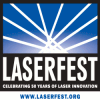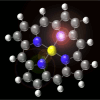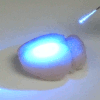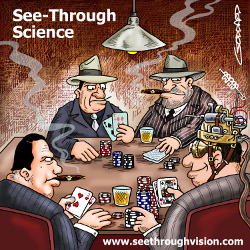-
Viewpoint on 'IONS'
Viewpoint on 'Scientific Literacy'
- Proudly sponsored by
-


-
Happy Birthday Laser!

This year the world celebrates the 50th birthday of the laser through an initiative jointly organized by various optics and photonics organizations: the LaserFest. Happy birthday laser!
-
The Ultimate Resolution

Even the best microscopes in the world cannot see the details of single molecules. Now, researchers have found a way to image these details, taking another step towards a better understanding of molecular physics and designer molecules.
-
Spooky Light

Many are afraid of darkness, but who gets spooked by light? Light has now been used to condition rats to fear, teaching us about fear memory formation.
THE INTERVIEW with Allard Mosk
Imaging through Scattering Media
Thanks to recent advances in Optics, looking trough turbid materials is no longer just a simple dream of few. In the following interview, Allard Mosk from the University of Twente takes us through a backstage tour of this fast emerging research field.
See-through science. Allard Mosk (1970) received his Ph.D. from the University of Amsterdam in 1999. Since 2002 he has been a member of the Complex Photonic Systems (COPS) group at the MESA+ Institute for Nanotechnology at the University of Twente in the Netherlands. His main fields of research are atomic quantum gases, thermodynamics, optics, and nanophotonics. His method has always been to complement experiments with deep theoretical knowledge of the phenomena involved. He enjoys enthusiastically presenting science to specialist and non-specialist audiences alike, and especially to students. With the support of the COPS group he has pioneered wavefront shaping to control light in opaque scattering media, an experimental method that many prominent groups worldwide are now following.
Imágenes a través de medios de disperción
and Portuguese
Gereção de imagens através de meios de dispersão,
brought to you by
Optics and Photonics Latin America
How would you define the field of imaging and light propagation through a scattering medium? What qualifies a medium as scattering?
“Scattering media are media through which you cannot see because the incident light waves get scattered by random inhomogeneities of the medium. Examples are milk, paper, or human skin. Of course, optics in scattering media has been of interest for quite a long time, and many successful methods have been developed to use light to look inside such media. An important example is optical coherence tomography, a method that separates the scattered light from the light that propagates in a straight line. This method is extremely powerful as long as some of the light has made it through without random scattering. Only recently, methods have been developed to use the coherent propagation of laser light for focusing and imaging. The underlying idea is that any medium, even a complex multiple-scattering medium, performs a transformation on the light field that you can undo by wavefront shaping or phase conjugation.”
Could you identify some scientific and technological milestones that kicked off research in this field?
“The idea to retrace the path of light based on its coherent propagation at least goes back to Leith and Upatnieks in 1966: they used a hologram to project an image back through a scattering medium [1]. At that time, it was not possible to do the same in real time with a biological medium. In fact, it was not until 2008 that Yaqoob and co-workers succeeded in doing this [2]: they were able, using a phase conjugating crystal, to project images through thin slices of chicken tissue. Both in the work of Leith and Upatnieks and in the later work by Yaqoob and co-workers, the image was back-projected to the position of the original object, so these methods were not useful in looking at what lay on the other side of the scattering medium. They did show, however, that the image information passes through it.”
“In 2007, my own group demonstrated that light could be focused through even extremely strongly scattering systems by shaping the incident wavefront [3]. To this end, we used megapixel light modulators that are now cheap and fast thanks to the developments in the electronics industry. The use of spatial light modulators in the optics of turbid media has since boomed: nowadays, there are several papers per month that report on new possibilities and new achievements. It turns out that much more is possible than I would have ever dreamt of.”
Could you take us through a short history of the field? How did it develop?
“After the initial realization that coherent light can be manipulated in a useful way, a few years went by with not much obvious activity. However, the initial works captured the attention of some very bright people who saw great applications for the developing technology. In 2010, we saw a great deal of new results, especially the use of digital optical phase conjugation, first shown by Changhuei Yang's group, and the use of DOPC in imaging through scattering media by Psaltis’ group. Another important advance was the first measurement of a large part of the optical transmission matrix by the team of Sylvain Gigan, and its subsequent use in imaging [4].”

Looking through an opaque material. In an experiment recently published in Nature, Allard Mosk and colleagues have succeeded in obtaining sharp pictures of objects hidden behind an opaque screen. (a) The test object used was the Greek letter ?, written in fluorescent ink. The test object was covered by a strongly scattering ground-glass diffuser that completely hid it from view. (b) A laser beam was then scanned at an angle, always hitting the diffuser in the same spot. The test object only yielded a diffuse glow of fluorescent light. (c) The intensity of this fluorescence versus the angle of the laser beam were measured and recorded by a computer. The seemingly random pattern bears no resemblance to the test objects. (d) The computer then searched for similarities in the measured pattern, which were used to calculate the true shape of the test object.
“When we started working in this field, it was not easy to even publish the first paper. Not many people were convinced that this could go beyond the level of a cute trick.”
The recent Nature article you have coauthored with other researchers in the Netherlands and Italy demonstrates the possibility of taking sharp images of an object hidden by a turbid medium [5]. How does this work place itself within the field?
“While looking for new ways to obtain images from scattered light, two very bright guys in my lab, Elbert van Putten and Jacopo Bertolotti, found a way to extract information from speckle correlations. If laser light is scattered by a thin layer, such as a glass diffuser or a sheet of paper, the speckles present subtle correlations that were thought to be useless for imaging as the speckles themselves are random. However, the trick is to apply a mathematical operation: We look at the autocorrelation of our optical signal that contains information about an object we want to image behind the scattering medium. The autocorrelation of the speckles is not random and can be extracted, so that we are left with the autocorrelation of the image we want to reconstruct. Extracting a picture from its autocorrelation, then, is not hard to do for a computer, given that we know some properties of the object.”
What are the main applications and outcomes you expect from the field?
“I am excited about a large number of applications that are on the horizon now. The first real-life applications may be in microscopy, where the high resolution that can be achieved with scattered light may be very valuable [6-8].”
The ability to see through turbid media brings superheroes or spy movies to mind. This may well sound like a cliché, since, as always, reality would seem to be much more complex and limited than fiction. Could you comment on this statement?
“As science progresses, some things in sci-fi movies become reality. Of all the fantastic technology in Star Trek, tablets have materialized. We hope of course to realize the tricorder. Someone else can do the warp drive.”
“Looking through thick walls with light, however, is never going to be a hit as simply too few photons pass to obtain an image.”
Keeping with the cliché side of this story… Are you more of a James Bond or more of a Superman kind of guy?
“Expelliarmus!”
To conclude, what do you envision lying ahead for this field?
“If only I could see that! Nevertheless, it would make me very happy if some of the technology we develop now can be used by doctors to save lives in the future.”
Interview by Giorgio Volpe
[1] E. N. Leith & J. Upatnieks, Holographic imagery through diffusing media, J. Opt. Soc. Am. 56, 523 (1966).
[2] Z. Yaqoob, D. Psaltis, M. S. Feld & C. Yang, Optical phase conjugation for turbidity in biological samples, Nature Photon. 2, 110-115 (2008).
[3] I. M. Vellekoop & A. P. Mosk, Focusing coherent light trough opaque strongly scattering media, Opt. Lett. 32, 2309-2311 (2007).
[4] S. M. Popoff, G. Lerosey, R. Carminati, M. Fink, A. C. Boccara & S. Gigan, Measuring the transmission matrix in optics: an approach to the study and control of light propagation in disordered media, Phys. Rev. Lett. 104, 100601 (2010).
[5] J. Bertolotti, E. G. van Putten, C. Blum, A. Lagendijk, W. L. Vos & A. P. Mosk, Non-invasive imaging through opaque scattering layers, Nature 491, 232-234 (2012).
[6] Y. Choi, T. D. Yang, C. Fang-Yen, P. Kang, K. J. Lee, R. R. Dasari, M. S. Feld & W. Choi, Overcaming the diffraction limit using multiple light scattering in a highly disordered medium, Phys. Rev. Lett. 107, 023902 (2011).
[7] E. G. van Putten, D. Akbulut, J. Bertolotti, W. L. Vos, A. Lagendijk & A. P. Mosk, Scattering lens resolves sub-100 nm structures with visible light, Phys. Rev. Lett. 106, 193905 (2011).
[8] I. M. Vellekoop, A. Lagendijk & A. P. Mosk, Exploiting disorder for perfect focusing, Nature Photon. 4, 320-322 (2010).
Allard Mosk
2013 © Optics & Photonics Focus
